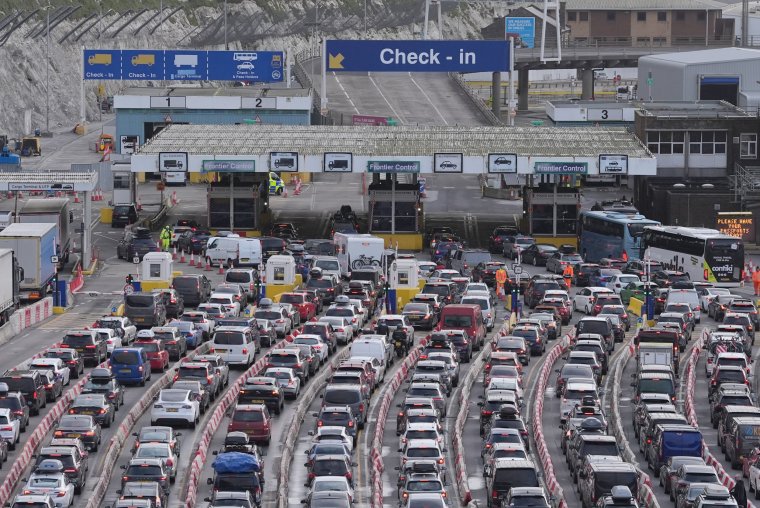12 October sees the start of a phased launch of Entry/Exit System (EES) fingerprint checks for non-EU citizens
Holidaymakers stuck in traffic chaos towards Dover and Eurotunnel after new EU post-Brexit border checks launch could be held at a motor racing track.
The Government has agreed a deal to use Lydden Hill Race Circuit in Kent as a holding area for passenger traffic to ease pressure on the M2 and M20 during long border delays.
October 12 sees the start of a phased launch of Entry/Exit System (EES) fingerprint checks for non-EU citizens heading to Europe’s Schengen area.
New FeatureIn ShortQuick Stories. Same trusted journalism.
Initially, EES biometrics will be required for coach passengers and freight, with travellers in cars undergoing the same checks from 1 November.
Eurotunnel in Folkestone, Eurostar at St Pancras in London and the Port of Dover have opened new registration kiosks which scan passports and take travellers’ photographs.
While checks at those juxtaposed border controls will be done on UK soil, people flying to the EU will be checked after landing at European airports.
It is understood Lydden Hill, near the A2 and nine miles from the Port of Dover, would be used in a worst-case scenario as a holding area for traffic that would be removed from the road during gridlock in Kent, with Government officials also looking for a suitable second site.
The mile-long circuit between Canterbury and Dover is used for motorsports such as rallycross.
Operation Brock, the traffic-holding system already in place since 2019, sees Dover-bound lorries queue on one side of the M20 while the other carriageway is split between traffic driving in both directions.
Meanwhile, pilot schemes to test an app allowing passengers to register their details before travelling are being planned by French authorities for next year.
Last year, Kent council leaders warned EES could lead to 14-hour queues and cause chaos on the roads, which may impact national food supplies.
But the Department for Transport (DfT) insists the phased implementation of EES and investments at Dover and Eurotunnel have “reduced significantly” the potential for disruption.
The new system’s first real stress test is expected next Easter holidays.
It is understood that Government modelling on congestion is currently being prepared and due to be finalised by the end of October.
A well-placed source told The i Paper: “When 14 hours was quoted last year, it’s not showing anything like as bad as that.
“But it’s so unpredictable, as we’ve seen in the summer just gone. One day, when PAF [Police aux Frontières – French border police] had problems and were taking three times as long to process, there were four hours of queues and Dover was gridlocked.
“So that’s the fragility of the whole system. It only takes a crash, a storm or a broken-down PAF system to not operate, whereas all of the modelling that you hear is based on everything doing what it should do.”
 Council leaders warned last year that the launch of EES could lead to queues of up to 14 hours (Photo: Gareth Fuller/PA Wire)
Council leaders warned last year that the launch of EES could lead to queues of up to 14 hours (Photo: Gareth Fuller/PA Wire)
The facial scans and data are only taken during a passenger’s initial EES registration and are valid for three years.
Last year, the Port of Dover installed a canopy on the eastern docks where passengers were due to have biometrics checks carried out through handheld tablets.
A trial in February 2024 showed the iPad-style devices due to be used had an 80 per cent failure rate, according to Therese West-Moore, head of port operations.
Dover has since located booths in the western docks of the port, which will carry out the vast majority of EES registrations, although some checks will still be done with handheld devices.
It is understood that improvements have been made in the device’s technology, but they have not been sent to the Port of Dover to be tested as of last week.
From 12 October, Coach passengers must alight from the bus to scan their passports and register at the kiosks before reboarding, with around 50 booths for cars due to be ready by November.
Port of Dover chief executive Doug Bannister told The i Paper he was “confident” about the EES launch, with the roll-out phased in from October until April 2026.
“We’ve agreed with France that we will follow the national picture in Dover, so we will start with 10 per cent [of passengers checked] and follow the milestones that progress up to 100 per cent,” he said.
“But we’ve also said that our desire is to be able to do more than the minimum that the regulation does, because that will be better for us.
“We’ve geared our facilities to be able to handle the peak traffic volumes, and with the progressive implementation, we will learn how best to optimise the process in advance of getting into the very busy tourist season.”
If queues become too long during the initial transition period, the port can temporarily stop EES and revert to manual passport stamping.
Previous years have seen Dover clogged up during problems at the port, with drivers stranded for hours on roads into the town.
 The Government has agreed a deal to use Lydden Hill as an overflow for traffic during delays caused by fingerprint checks at Dover (Photo: Jordan Mansfield/Getty)
The Government has agreed a deal to use Lydden Hill as an overflow for traffic during delays caused by fingerprint checks at Dover (Photo: Jordan Mansfield/Getty)
Kevin Mills, leader of Dover District Council, said: “The real concern is Easter. All things being equal, Europe want us to be doing 100 per cent checks at the busiest time of the year.
“So you’d hope that any teething problems have been ironed out at that stage. But it still has the potential to cause problems.
“Whenever we see an issue in Dover, all we’re told normally is that’s down to the PAF, or an IT problem in France. Well, this is all European technology, so we need to ensure that there’s a fallback position should something go wrong.”
A DfT spokesperson said: “The phased implementation of EES and the significant investments made by the Port of Dover and Eurotunnel have significantly reduced the potential for disruption.
“As a responsible Government, we have sought to strengthen the existing, well-tested, resilience measures across the Kent road network.
“The contract with Lydden Hill Race Circuit adds to the suite of traffic management measures available to the Kent and Medway Resilience Forum.”
